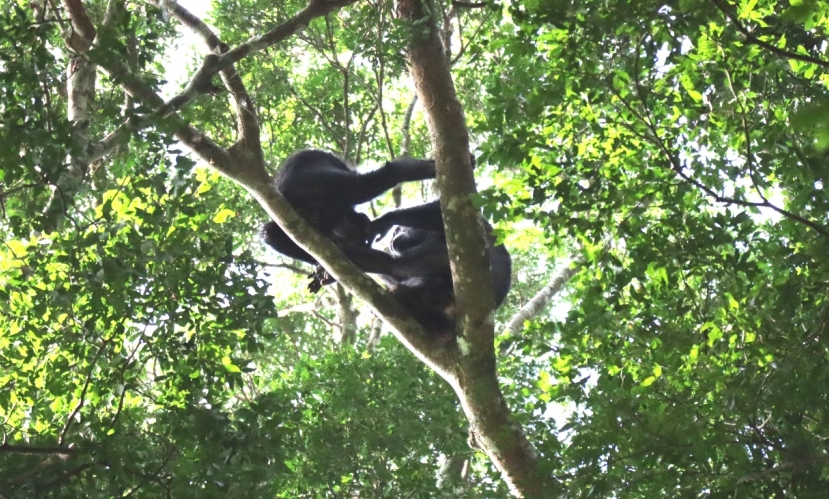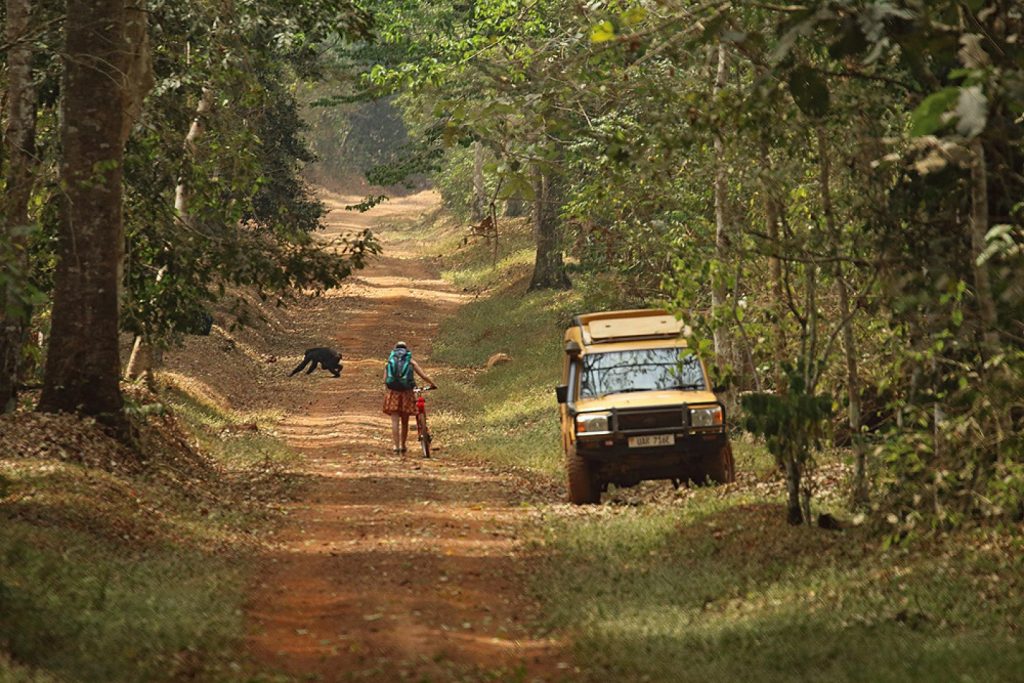The Budongo Forest in Uganda is on way to Murchison Falls National Park, located northwest of Kampala, the capital city of Uganda. The Park is on the escarpment, northeast of Lake Albert. Budongo forest is known for its former abundance of East African mahogany trees as well as being home to a population of chimpanzees. An exceptionally large mahogany trees are still found here, which are more than 80 meters tall and about 20 meters in circumference.
Most visitors to the forest come for birding or chimpanzee tracking, however, there is more to do and see here, especially if you enjoy hiking.

Budongo forest is the biggest Mahogany Forest found in the whole of East Africa, as well as habitat to the largest number of chimpanzees throughout Uganda. The major tourist sites within this forest are the Kaniyo Pabidi Ecotourism site and Busingiro Ecotourism site, which are located at the boundary of Murchison Falls National Park and dominated by mahogany and iron-wood trees. The 115-kilometer expanse is a remote chunk of the Budongo forest. Its isolation once in a while offers a safe haven for lions, leopards as well as buffaloes.
Location and access of Budongo Forest Uganda
Budongo Forest and the Kaniyo Pabidi are easily accessed from Kampala, along the road to Murchison Falls Park, and can take about 3 1/2 hours from or to Kampala, depending on road conditions.
The area, situated between 1° 37 N – 2° 03 N and 31° 22 – 31° 46 E, is 435 km² in extent and is composed mainly of moist, medium-altitude, semi-deciduous forest, with patches of savanna and woodland. It covers a gently rolling landscape, sloping down to the East African Rift.
Four streams, Waisoke, Sonso, Kamirambwa and Siba, drain the forest and flow into Lake Albert. Annual rainfall in the area is between 1200 and 2200 mm, the rainy season being from March – May and again from September – November, the dry season being December – February.
The nearest town is Masindi, and much of the land around the forest is given over to crops, dwellings and villages, placing continuous pressure on the forest margins, and leading to exploitation for building materials and bushmeat, the snares set by poachers causing mutilation of the chimpanzees and other animals. The mahogany trees that still remain are cut and removed by itinerant pit sawyers.
Biodiversity of Budongo Forest Uganda
Budongo forest is one of its kind, a place where tourism is highly practiced. Recorded from Budongo are more than 360 bird species, some 290 butterflies, 130 moths, 465 trees, and 24 mammals, of which 9 are primates.
Chimpanzee tracking has become an activity popular with eco-tourists, necessitating behavioural guidelines for visitors in order to avoid undue disturbance of both animals and forest. Trails have been cut crisscrossing the forest, initially to ease access for research workers and since then used by visitors.
Budongo forest has a rich biodiversity of wildlife, and it is a home to over 9 species of primates. The forest is a natural habitat to over 600 chimpanzees, of which a small community has been habituated for eco-tourism purposes. This family consists of over 80 individuals permitting visitors an outstanding opportunity to view these incredible apes in their natural location.
Other primate species include the black and white colobus monkeys, blue monkeys, Olive baboons, and grey –cheeked mangabeys. Not only primates but the forest reserve is a home to more than 24 species of small mammals, 280 butterflies, 465 species of trees and shrubs.
Tourism activities in the forest include

Chimpanzee Tracking experience
A walk is taken into the forest with help of a guide to track the chimpanzees. Vocal sound and buttress drumming from the chimps help to allocate them. A period of an hour is spent with the chimps with visitors trying to have a look at chimps.
This is the number one priority here. October to January is the time when the fruits are shorter in supply, so the chimps move a lot covering a wider area. As a result, the success of seeing them drops to about 50% rate. Fortunately, there is a diversity of accommodation facilities available from where you can base to enjoy the chimpanzee trekking experience as well as the exciting forest walks.
Chimpanzee Habituation Experience in Budongo Forest
Chimpanzee Habituation Experience, which is an all-day activity, can be done here during off-season months. These are the low seasons running from March to mid-June and October to December.
The chimpanzee habituation experience is done with researchers and others – a process which takes up to two years. The Jane Goodall Institute manages and oversees chimpanzees in Budongo Forest and has done so for many years.
The habituation experience cost is considerably lower here than in it is in Kibale Forest National Park, however, here chimpanzee habituation can be done all year long. If you want to engage in chimpanzee habituation, we recommend an overnight stay at the Budongo Eco-Lodge.
Birding in Budongo Forest
The forest is among the most ideal places in Uganda to have a guided bird watching tour by the Royal Mile that extends from Nyabyeya Forestry College to the research station.
Among the various bird species that have been recorded in this forest are more than 360 species. These will certainly reward you with a very amazing birding safari experience in this great forest in Uganda. In addition, there are 290 butterfly species, 130 moth species, 465 tree species, as well as 24 mammals – nine of which are actually primates.
Guided Nature Walks in Budongo Forest
Guided nature walks can be taken here through woodland and savanna terrain. Unknown to most visitors, a variety of wildlife can also be seen here on your nature walk and hike safaris. This is because Budongo Forest is part of Murchison Falls Wildlife Reserve, so animals come from the park, while some live here. Others visit and return to their regular habitat.
You can spot wildlife licking salt in in the forest clearings. Large mammals also wander into this part of park such as elephants, lions, buffaloes and leopards. A guided nature walk does not endanger you in any way, that’s why no one has ever been hurt here because you will be with armed rangers.
Due to the biodiversity of Murchison Falls National Park, the park stands out as the best place for wildlife safaris in Uganda and for short weekend breaks for both wildlife and nature lovers.
